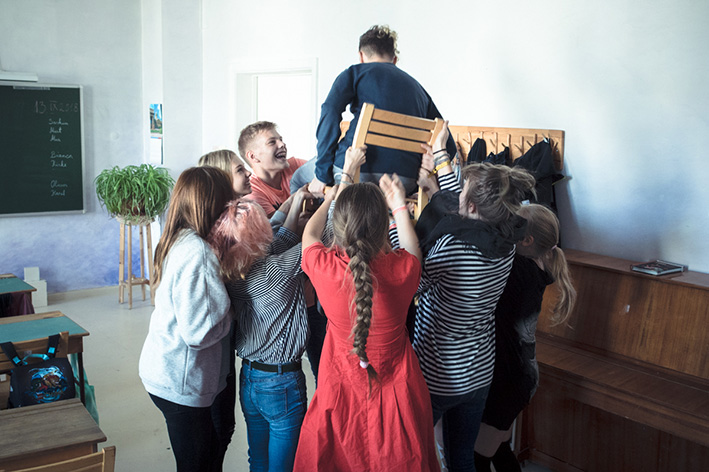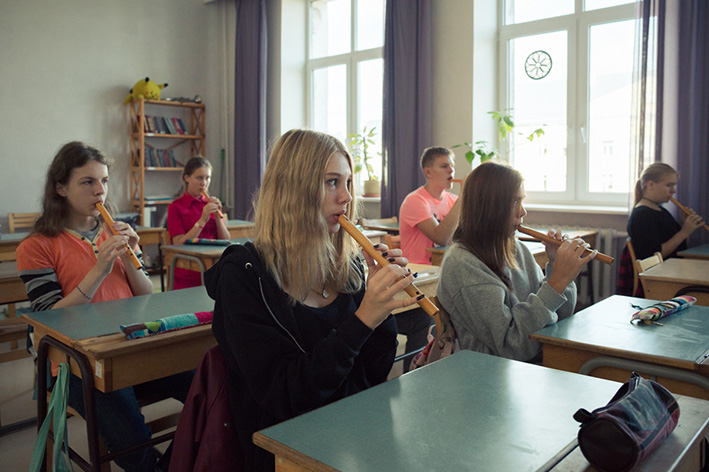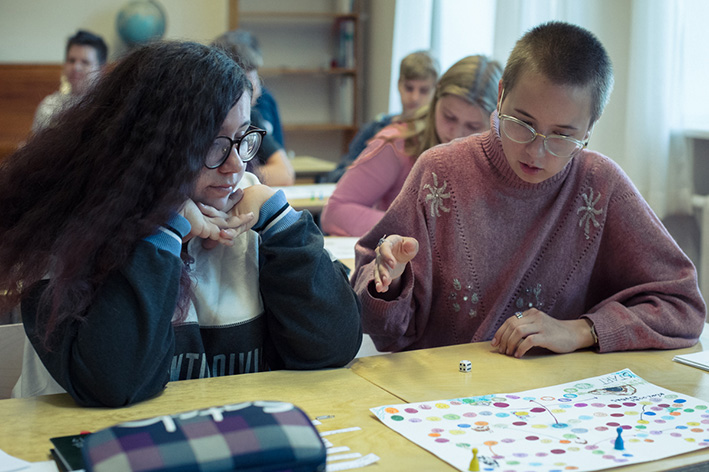Go-Far 2018: Eye on Estonia

Students celebrate their classmate’s 14th birthday by raising him up and down on a chair 14 times.
Photo by: Elina Kostabi
More enrol in parent-owned schools
Waldorf schools offer an alternative and encourage creativity over rote learning
By Gracia Lee
When it was time for Ms Piret Meier’s three children to enter primary school, she moved her family about 130km from their hometown in Pärnu to Tallinn just so she could enroll them in Tallinn Free Waldorf School.
Ms Meier liked that the school placed a big emphasis on creativity and allowed students to learn at their own pace. This was unlike public schools, which she said were too stressful and competitive.
“I wanted something more playful and fun for my children,” said the 55-year-old, who also teaches handiwork at the school.
Some parents like Ms Meier, dissatisfied with how public schools are run, are putting their children in private schools based in Waldorf pedagogy, which are set up by like-minded parents who want a more holistic education for their children.
Devised by Austrian educational philosopher Rudolf Steiner in 1919, Waldorf education emphasises the role of imagination in learning and strives to integrate the intellectual, practical and artistic development of a student.
There are nine such parent-owned schools in Estonia, with four set up in the last ten years. According to the Association of Free Waldorf Schools and Kindergartens of Estonia, there are almost 1,200 students this year — more than twice the number five years ago — making up about one per cent of the 153,000 school-going children.
Parents pay between 500 and 1,200 euros in school fees each year, whereas public schools are free.
Chairman of the Estonian Parent Association Aivar Haller, 57, a parent who helped to set up Tallinn Free Waldorf School in 2001, said public schools focus too much on results, killing students’ joy of learning.
“The students do well in the subject, but they don’t like it. They don’t enjoy it,” said the father of three.
The Waldorf schools hope to develop in students a love for learning by encouraging creativity and allowing for space to fail.
“Results and assessments say that making mistakes is wrong. But much more important than results is the process of learning,” said Mr Haller.
Students at the school are not given grades until Grade 9. Instead, they are given written feedback for each subject at the end of the year, where teachers highlight their strengths and elaborate on ways that they can improve.
Ms Kristina Sanin, head of Tallinn Free Waldorf School, said: “If I say to a student that his grade is 3 out of 5… it doesn’t help him. But if I tell him that he must pay attention to details to understand more, then he knows what he must do.”
She added that this also reduces competition between students and avoids creating feelings of inferiority among weaker pupils.
Class sizes are also kept under 20 so each student gets more attention from teachers. Each class has a teacher that stays with them from Grade 1 to Grade 8. This creates a deep connection that allows teachers to be more aware of and sensitive to students’ needs, said Ms Sanin.
While Estonian schools are introducing devices to children as young as in kindergarten, computers and tablets at the Waldorf schools are only used in high school.
Ms Anne-Lii Kerge, head of Tartu Waldorf Gymnasium, said it takes time and maturity for children to be responsible media users.
“If media is introduced too early… they just drown themselves in it and don’t look at what happens around them anymore, which is not good,” said Ms Kerge, whose 17-year-old son attends the school.
Mr Haller believes that delaying the introduction of these devices does not put students at a disadvantage but helps them become more competent users in the future.
“Withholding media at an early age allows creativity to unfold and creates an excellent foundation for further rapid development,” he explained, adding that several pupils from these Waldorf schools have won technology competitions.
“Everything must start at an appropriate time,” said Mr Haller.

Students in the eighth grade start their lessons by playing on their block flutes.
The schools also place a great emphasis on developing creativity. The walls at Tallinn Free Waldorf School are plastered with students’ drawings and paintings, while pianos and shelves of cloth, yarn, crayons and bicycle parts line the corridors.
Ms Sanin said about 40 per cent of students’ time is spent on subjects required in the national curriculum, such as language, science, mathematics and the humanities.

Students in the eighth grade start their lessons by playing on their block flutes.
Lessons often integrate at least two subjects, such as physics and math or history and literature, to help students see that “the world is not separated” into different subjects, she said.
The rest of the time is spent on art, music, drama and physical education. All students are taught how to play the flute and have opportunities to work with paint, pottery, wood, metal and textiles.
This is a huge draw for Ms Kart Ulman, 56, a news editor, who believes in the importance of learning art forms. Her youngest son, who is 17, attends Tallinn Free Waldorf School.
While music and art are compulsory subjects in the national curriculum, Ms Ulman feels such subjects are starting to be seen as less important in Estonian society.
“It is unfortunate because art and music education teaches kids so many other qualities that they need in their lives, like self-expression and teamwork,” she said.
Students from the Tallinn Free Waldorf School achieve average results at the state examinations and about 70 per cent of graduates enter university, said Ms Sanin.
Alumnus Kristel Kolkanen, 20, who graduated last year and is now studying music composition at Georg Otsa Tallinn School of Music, said classes were engaging and taught her how to “think out of the box”.
“In high school, a lot of friends my age who were in public schools were so done with school and didn’t want to hear or see anything about it. But I was still happy to go to school and eager to continue studying,” she said.
At the end of the day, the goal of the school is not to produce the smartest students but to develop in pupils a knowledge of their strengths and weaknesses, said Ms Sanin.
“Every person is unique. It’s normal that some students are good in some areas and not so good in others. We want our students to know who they are… and what they can give to the world,” she said.